Water, by its simplest definition, is life. Every living thing on Earth requires water to survive. Water means different things to different people. The conversation on World Water Day centers on solving the global water and sanitation crisis, which will require everyone to do their part. To help with this discussion we are sharing information about World Water Day, sustaining water, the water cycle, why water is so essential for human life and more!
Water means different things to different people. In households, schools and workplaces, water can mean health, hygiene, dignity and productivity. In cultural, religious and spiritual places, water can mean a connection with creation, community and oneself. In natural spaces, water can mean peace, harmony and preservation. Today, water is under extreme threat from a growing population, increasing demands of agriculture and industry, and the worsening impacts of climate change. UN World Water Day welcomes everyone to tell their stories, thoughts and feelings about water. Visit the World Water Day website for tools to help you learn share and act to protect and preserve water.
Download resources to get involved this World Water Day and find out more about the connection between water and peace.
World Water Day - Water for Peace
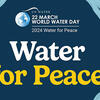
The UN World Water Day 2024 global theme is "Water for Peace" Water can create peace or spark conflict. When water is scarce or polluted, or when people have unequal or no access, tensions can rise. Access to drinking water is a human right. There is an urgent need to work together to protect and conserve our most precious resource. Cooperation on water paves the way for cooperation on all shared challenges. We must use water as a tool to create a more peaceful and prosperous world for all.
The water-related impacts of climate change are worsening and a growing global population is placing increasing demand on a finite resource. Within many countries, people’s access to safe drinking water is unevenly and unfairly distributed. Between countries, the widespread lack of transboundary cooperation on shared water resources poses a risk to the quality and quantity of water supplies and therefore threatens social and international stability.
Poor provision of water services can delegitimize States. The inability of a government to provide basic water services can lead to a delegitimization of State institutions and ignite social unrest, especially in the context of food insecurity, high unemployment and internal migration. Learn more.
A Look Back: UN Water Conference
In 1977, world leaders, water experts and policymakers from around the world gathered in Mar del Plata, Argentina, for the UN Water Conference. Almost 50 years later, the global community came together in 2023 in New York for the second ever UN Water Conference.
By nature, water connects different environments, peoples and sectors. But growing demands for water, coupled with poor water management, have increased water stress around the world. Meanwhile, the effects of worsening climate change are often felt through water, in the form of floods or droughts. Something has to change. Halfway into the Water Action Decade, our progress on water-related goals and targets remains alarmingly off-track, jeopardizing the entire sustainable development agenda.
The UN Water Conference put water into the spotlight and onto global agendas. It seeks to mobilize States, the UN system and stakeholders alike to share and exchange knowledge, challenges and best practices, and forge new partnerships across sectors. Governance, innovation, data and financing all have a role to play in accelerating water action. Learn more.
Water For Health: Access to Wash, Including the Human Rights to Safe Drinking Water and Sanitation
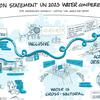
Ahead of the UN Water Conference, and in the spirit of its inclusivity an artist was commissioned to portray the key themes of the Conference in a visually engaging format. Each of these five cartoons represents one of the themes of the Conference’s Interactive Dialogues and its building blocks which aim to galvanize water action. See more (scroll down).
The History of World Water Day
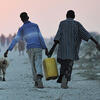
World Water Day focuses on the importance of freshwater. World Water Day celebrates water and raises awareness of the 2.2 billion people living without access to safe water. The idea for this international day goes back to 1992, the year in which the United Nations Conference on Environment and Development in Rio de Janeiro took place. That same year, the United Nations General Assembly adopted a resolution by which March 22 of each year was declared World Day for Water, to be observed starting in 1993. Later on, other celebrations and events were added. For instance, the International Year of Cooperation in the Water Sphere 2013, and the current International Decade for Action on Water for Sustainable Development, 2018-2028. These observances serve to reaffirm that water and sanitation measures are key to poverty reduction, economic growth, and environmental sustainability. Photo by UN Photo.
UNESCO World Water Development Report

The United Nations World Water Development Report (UN WWDR) is an annual and thematic report that focuses on different strategic water issues each year and aims to provide decision-makers with the tools to implement sustainable use of our water resources. It also includes regional aspects, hotspots, examples and stories, making the report relevant to a broad range of readers, at different levels and in different geographical areas.
The UN’s flagship report on water and sanitation is launched every year on World Water Day, 22 March. The 2024 edition will explore the theme of "Water for prosperity and peace." The 2023 report, Partnerships and Cooperation for Water, launched on March 22, 2023 at the United Nations 2023 Water Conference in New York. The 2022 report theme was, “Groundwater – Making the Invisible Visible;" the 2021 report highlighted "Valuing Water," 2020's theme was "Water and Climate Change," 2019 focused on "Leaving No One Behind," and 2018 placed a spotlight on "Nature-Based Solitions for Water."
The 2023 UN World Water Development Report
At current rates, progress towards the Sustainable Development Goal for water and sanitation (SDG 6) is off-track.
The United Nations World Water Development Report 2023 on “Partnerships and cooperation for water” describes how building partnerships and enhancing cooperation across all dimensions of sustainable development are essential to accelerating progress towards SDG 6 and realizing the human rights to water and sanitation.
The United Nations World Water Development Report 2023 will be launched at the UN 2023 Water Conference in New York, on 22 March 2023. For more information please visit https://en.unesco.org/wwap.
The Earth's Fresh and Salt Water
Did you know only about three percent of the water on Earth is fresh water? That's why we need to take care of it! In this video from FunScienceDemos, Jared shows us how much salt water there is compared to the freshwater we have on our planet. Temple University's College of Science and Technology offers a wonderful series of FunScienceDemos in cooperation with TuTeach. This video is used with permission from the College of Science and Technology, TuTeach and the incredible FunScienceDemos team.
Moving Water Shapes the Land
Water is an incredibly powerful natural force, so powerful it can shape the land around us. Standing in a running stream, Jared explains that land is shaped by moving water, in this video from FunScienceDemos. This video is used with permission from the College of Science and Technology, TuTeach and the FunScienceDemos team.
Water for a Sustainable World: A Vision for 2050
This video from the United Nations Educational, Scientific and Cultural Oranization (UNESCO) presents the vision for 2050 of the world's water future. It is the UN’s flagship report on water and gives an overall picture of the state of the world's freshwater resources, aiming to provide decision-makers with the tools to implement sustainable use of water.
What Would Happen if You Didn't Drink Water?
Water is essentially everywhere in our world, and the average human is composed of between 55 and 60 percent water. So what role does water play in our bodies, and how much do we actually need to drink to stay healthy? Mia Nacamulli details the health benefits of hydration in this video from TedEd.
Why is Water Important?
Did you know that humans can only live a few days without water? In this video from Whizbusters, learn why water is the most important factor to human life after air!
Fifteen Benefits of Drinking Water
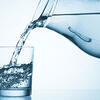
Around 60 percent of the body is made up of water, and around 71 percent of the planet’s surface is covered by water. Perhaps it is the ubiquitous nature of water that means drinking enough each day is not at the top of many people’s lists of priorities, but it should be according to Medical News Today.
How Much Water is There on Earth?

The Earth is a watery place. But just how much water exists on, in, and above our planet? About 71 percent of the Earth's surface is water-covered, and the oceans hold about 96.5 percent of all Earth's water. Water also exists in the air as water vapor, in rivers and lakes, in icecaps and glaciers, in the ground as soil moisture and in aquifers, and even in you and your dog. The globe illustration created by the U.S. Geological Survey (USGS) shows blue spheres representing relative amounts of Earth's water in comparison to the size of the Earth. Are you surprised that these water spheres look so small? Discover more!
Where is Earth's Water?
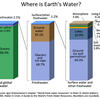
Earth's water is (almost) everywhere: above the Earth in the air and clouds, on the surface of the Earth in rivers, oceans, ice, plants, in living organisms, and inside the Earth in the top few miles of the ground. For an estimated explanation of where Earth's water exists, look at this bar chart shared by the U.S. Geological Survey (USGS). You may know that the water cycle describes the movement of Earth's water, so realize that the chart and table below represent the presence of Earth's water at a single point in time. If you check back in a million years, no doubt these numbers will be different!
The Water Cycle for Schools

Earth's water is always in movement, and the natural water cycle, also known as the hydrologic cycle, describes the continuous movement of water on, above, and below the surface of the Earth. Water is always changing states between liquid, vapor, and ice, with these processes happening in the blink of an eye and over millions of years. The U.S. Geological Survey (USGS) and the Food and Agriculture Organization of the United Nations (FAO) have teamed up to create a water-cycle diagram for schools and kids. It is available in over 30 languages and also in an interactive version made for online viewing and investigating.
More About The Water Cycle
Water is almost constantly changing, but like almost everything it does follow a pattern. From evaporation to condensation to precipitation, learn more about the water cycle in this video from Happy Learning!

